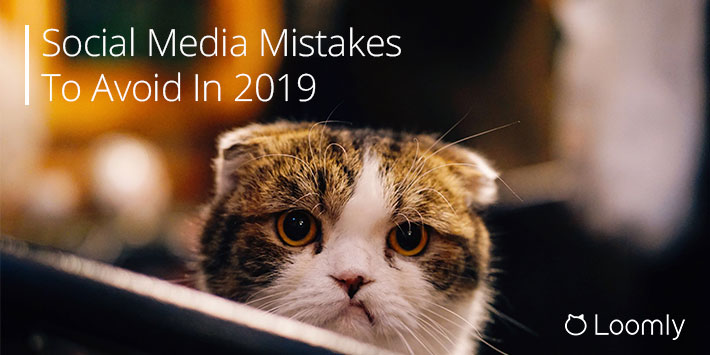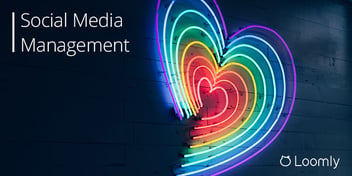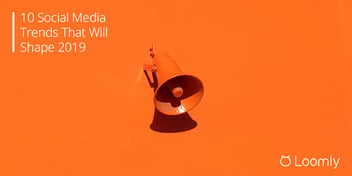Social media mistakes are bound to happen. (We are only human!)
But there is a big difference between the occasional typo and the kind of social media mistake which can stop your campaign dead in its tracks.
One of them needs an apology tweet, the other, well…
It can result in HR meetings, budget cuts, litigation and call the entire value of social media into question.
“We do not have a choice on whether we do social media, the question is how well we do it.” — Erik Qualman
In this article, we want to look at ten of the most common social media mistakes we can all inadvertently make, and provide solution to solve those right away.
Table of Content
- Not Setting Goals For Your Campaigns
- Not Having A Content Strateg
- Not Planning (And Creating) Content In Advance
- Not Having An Approval Process
- Not Using Data To Inform Decisions
- Not Interacting With Comments, Messages or @Mentions
- Not Creating Original Content
- Trying To Win On Every Platform
- Using Only High-Traffic Hashtags
- Trying To Beat The Algorithm
1. Not Setting Goals For Your Campaigns
One of the biggest social media mistakes we see is running campaigns without clear, actionable and measurable goals.
If you have ever felt like you are just posting for posting’s sake, this might be the root of the issue.
Having a clear goal helps you to understand the why behind every update and choose the appropriate metrics to track its success.
As you will see later in this article, the data you collect from your social media analytics will influence the future of your entire strategy.
If you feel unsure about what a social media goal looks like, or what you should be working towards, here are some examples of common goals and their metrics:
- Boost brand awareness: improve your reach and engagement
- Increase engagement: increase your follower counts, post interactions, and social mentions
- Drive traffic: increase the number of people who visit your website or shop
- Generate leads: put yourself in front of potential new customers
- Increase revenue: increase sign-ups or sales
- Provide customer service: solve your customer’s problems
You can already see how each of these goals would need a different kind of update, and be tracked using different types of analytics.
You can keep this goal general across all social media channels if you want to. Or, you can break it down on a channel-by-channel basis. (Perhaps you want to drive traffic on Facebook, but Twitter is your customer service hub.)
Either way, setting a goal can improve your campaign’s effectiveness and help you build a data-driven, long-term, social media strategy.
Speaking of which…
2. Not Having A Content Strategy
A content strategy bridges the gap between your business goals and your social media actions.
You identify what you want to achieve, define how that looks in social media terms, and then create content which helps you elicit the correct response.
This image will give you a deeper insight into what we mean:
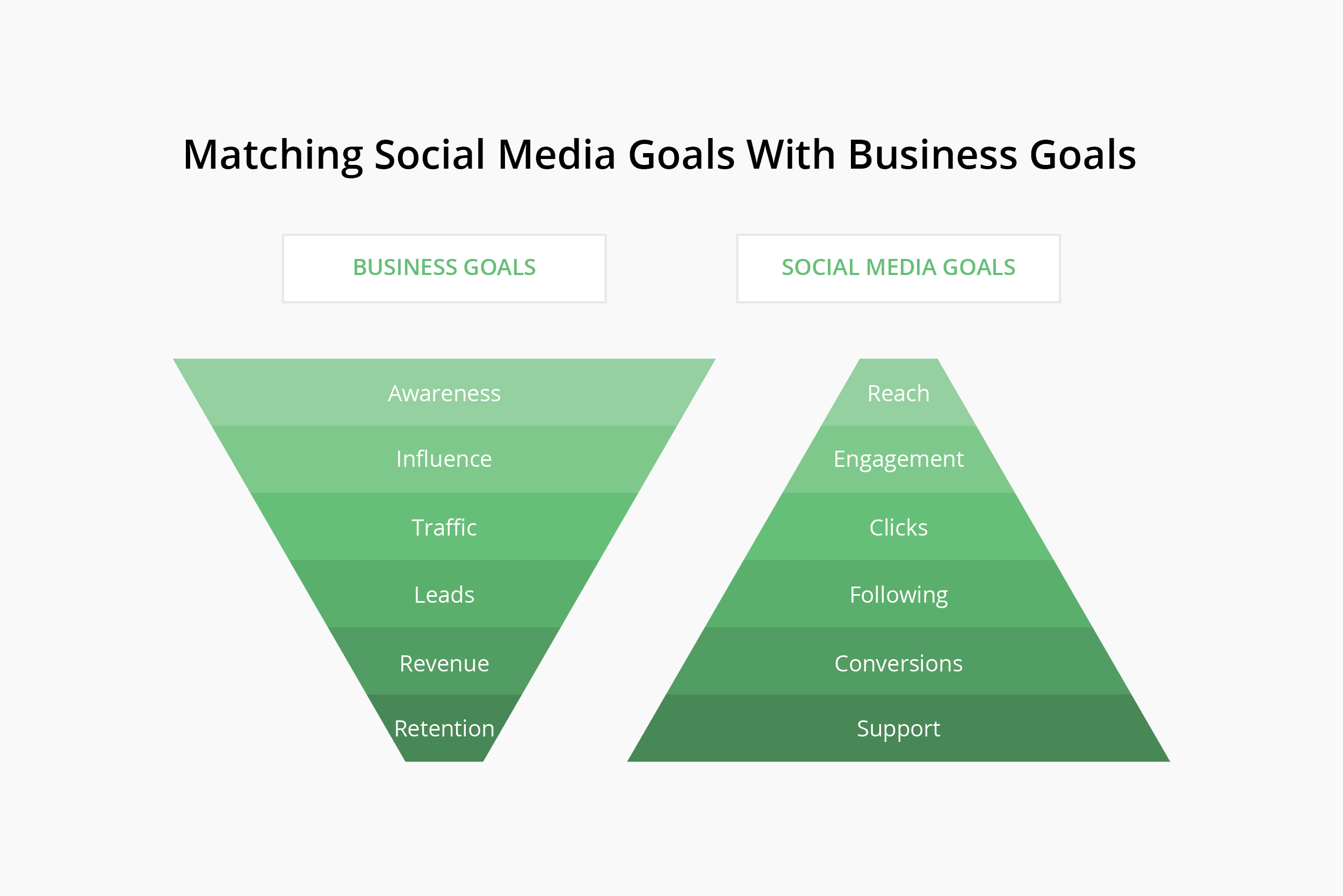
Working without a content strategy is one of the key social media mistakes to avoid, yet one so many of us, social media managers and marketers, can make.
3. Not Planning (And Creating) Content In Advance
Another one of the most common mistakes we see is running a reactive content strategy.
Meaning, you are frantically trying to publish content on a tight-deadline, when the “we really need to post today!”, panic sets in:

The last-minute strategy is a stressful way to run your social media feed which leads to low quality, sporadic, updates plagued with errors.
Let’s face it:
Tight deadlines do not provide the breathing room you need to create the updates your audience want.
And, with the number of social media calendars and scheduling tools available, it is an easy social media mistake to avoid in 2019.
A social media calendar, like Loomly, can help you turn your reactive strategy into a proactive one. Why?
Because you can create and schedule updates hours, days, weeks — or even months — in advance. It also gives you the opportunity to implement approval workflows (more on that next), to ensure high quality, error-free updates which capture your brand message.
“It can be easy to become ‘friends’ or ‘connected’ with someone in a digital world, but it requires thought and strategy to convert social media connections into rewarding business relationships.” — Lewis Howes
4. Not Having An Approval Process
Errors in your updates can be costly. And, we are not just talking about typos!

When social media is run independently from other teams in your business — like sales, product and legal — you can find yourself facing liability issues or sharing incorrect information.
It is important to implement a social media workflow which includes relevant members from all of the different teams in your business.
If you want to learn more about how to that, you can checkout our guide here.
5. Not Using Data To Inform Decisions
Social media analytics give you valuable insights into your audience which can help shape your entire content strategy and editorial calendar.
They are a crucial part of the social media publishing process, but they are often the most overlooked:
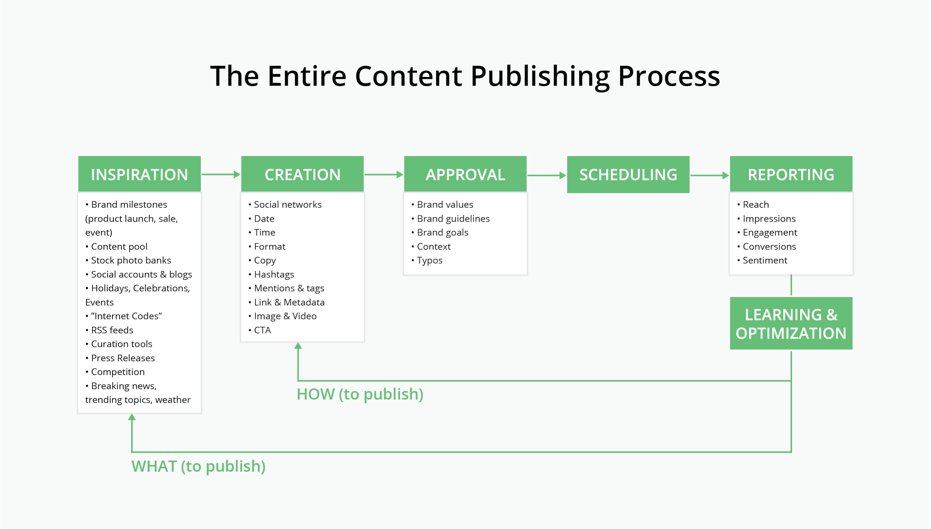
The data you collect from your updates (or campaigns) will help inform two major decisions:
- WHAT to publish: the types of content which take you towards your goal.
- HOW to publish: the specific aspects of your content, from the time published to the platform you use.
You can then apply what you’ve found, test it, and see what impact it has on your overall strategy. Does it move the needle, or do you need to try something new? Once tested, you can assess the data and make other adjustments. Wash, rinse and repeat.
If we are honest, we tend to avoid social media analytics because they can be overwhelming. There is a lot of data, and it is hard to know what to do with it.
6. Not Interacting With Comments, Messages or @Mentions
You are making a huge social media mistake if you do not interact with your users.
84% of consumers expect you to respond to social media interactions within 24 hours, and 48% of users are prompted to purchase by being responsive.
Not responding, then, can damage your brand and customer service, while costing you real sales opportunities. Which makes it all the more surprising to see post comments sections that look like this:

If you are currently guilty of this, do not worry. All is not lost!
The root cause of this problem is social media management: it’s essentially a matter of finding and dedicating the time, energy and resources responding to user interactions in a timely fashion.
You can take the tips from the last section, and publish well in advance, to ensure you have time each day to commit to this. But ideally, you also want to create a social media management workflow, and decide:
- Who is responsible for interactions
- Your deadline for responses (under 24 hours, for instance)
- How to handle tricky interactions (like sales questions, or support queries)
Your responses do not need to be over the top, or blog-post long interactions, either. Like AppSumo have perfectly well done here, it can just be a quick acknowledgment of their comment or a helpful link:
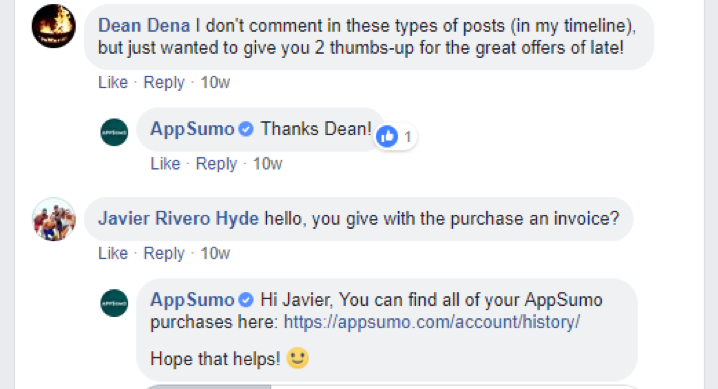
You really can’t afford to make this social media mistake in 2019, where expectations and demands for social interactions are only going to continue to grow.
7. Not Creating Original Content
There are two reasons original content is paramount for the future of social media.
The first is pretty practical:
Social media networks are now banning duplicate content in favor of original content.
In official updates, both Twitter and Facebook are looking to reduce the amount of spam, duplicate or unoriginal content in the news feed.
If your social media strategy hinges on curated content, then, you are unlikely to see great amounts of reach (or success) on some of social media’s major platforms.
The second reason is about the future of social media.
Brand storytelling is now at the heart of social media.
Content created by you (or your company), which has the power to spark emotion, tell stories, make inside jokes and speak directly to the audience you care about, is becoming the cornerstone of great social media campaigns.
Vox is a great example of original content done right. They create timely news stories and documentaries using their unique voice, across a wide array of social channels.
Their video content really stands out, like this mini-documentary on how IKEA’s floor plan can convince you to purchase more furniture:
Although you could argue their ideas are curated — news stories, current affairs, etc. — they are told in a unique and well-branded way. You know you are watching Vox content.
The brilliance of original content is its ability to go deep and wide.
You can boost engagement and increase sales with your existing audience, but it also has the potential to drive growth in both brand awareness and traffic. Why?
Because original content conveys a targeted message to your existing audience. But, is also likely to be picked up by third-party people who want to share a similar message.
Like when NPR picked up Vox’s video and shared it with their six million page followers:
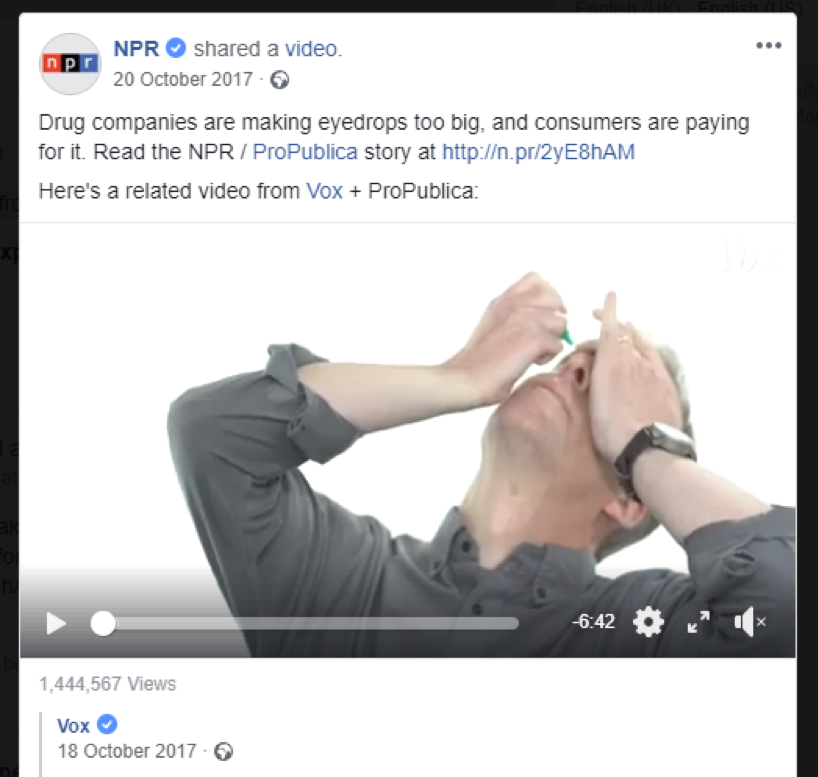
Better still:
Creating original content does not need to break the bank.
There is no shortage of free (or inexpensive) tools you can use to create original assets for your updates, like images, videos, GIFs and text.
You should also check out Gary Vee’s content deck, where he shows you how to take one long-form piece of original content — like a blog post, speech or podcast episode — and turn it into multiple pieces of smaller content to post.
Where possible, look to create original and story-driven content which speaks directly to your audience.
“Part of having a social media strategy is being smart about whom you follow. Ask yourself who is important to your company or brand. Figure out who needs to know you exist.” — Michelle Phan
8. Trying To Win On Every Platform
Do you know what is going to be the easiest social media mistake to make in 2019?
Spreading yourself too thin.
It often feels like you need to be present, and be super successful, on every social media platform.
Although we have never met a social media manager in the world who would not love that, it could not be further from the truth. Allow us to explain…
The real goal is to build a following and create content on the correct platforms. The ones where your audience spends their time and present you with an opportunity to create a real and deep connection.
If your target audience is 40- to 49-year-old female professionals in the business-to-business space, you do not need to spend much time making Pinterest infographics. Even if the demographic kind of fits, the mindset is different.
Likewise, if you want to target millennials who are interested in trail running, it does not really matter how large or responsive your LinkedIn following is. They probably do not care to hear about the latest news while they are in a workplace mindset.
To simplify this research for you, we made a cheat sheet to provide a little more insight into each platform:
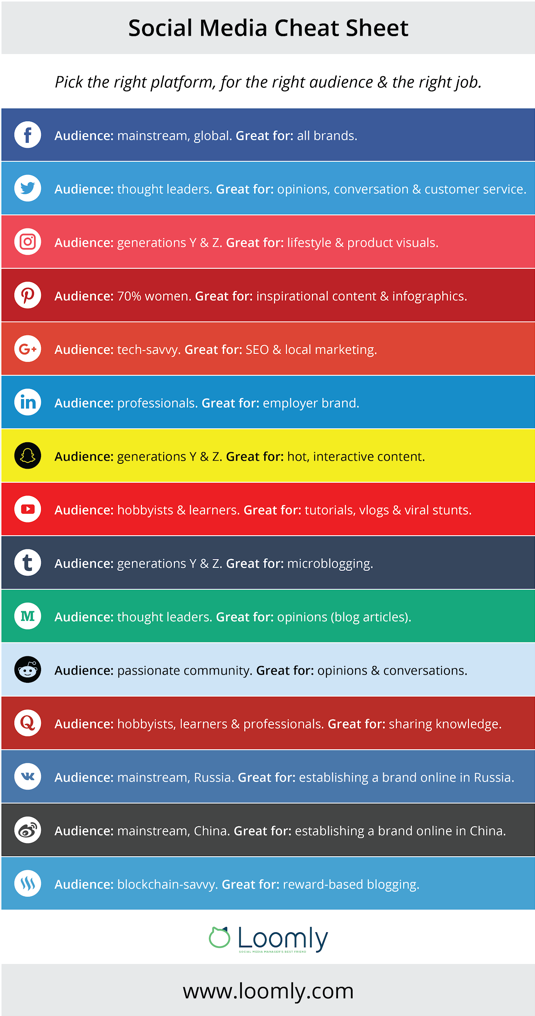
Take the time to figure out the right platform for your audience, and you will make your social media campaigns less stressful and more effective.
9. Using Only High-Traffic Hashtags
An easy social media mistake to make is using high-traffic hashtags.
These are the hashtags which are used and followed, by millions of people. They are usually short words or common phrases like:
- #love
- #instagood
- #run
- #style
- #selfie
- #picoftheday
- #food
- #nofilter
They are attractive for social media marketing because they create the illusion they will generate lots of traffic and likes. But, that is not really the case.
Hashtags like this have a lot of competition, and the turnover of posts in the news feed is really quick. Take a look…
Here is a screenshot of the hashtag “Instagood” taken at 2:41pm:

And here is the same page refreshed 30 seconds later:

You can only see the top six images in the screenshots, but the entire top 50 had changed in less than 30 seconds.
Because of this, it is almost impossible to get more than a flash of visibility for these “top” hashtags. The general rule of thumb is, the more they are used, the less you will be seen.
It is important, then, to drill down and find the lower-traffic, but highly targeted, hashtags which will allow you to be seen for longer.
For example, let us say you wanted to share a motivational update about a recent run for a sports brand. The hashtag “#run” has around 4 million uses.
But, a quick bit of research shows us:
- #runningmotivation – 758,000
- #runningterritory – 208,000
- #runningworld – 93,690
All of which would provide more exposure to your updates and still hit a targeted audience.
10. Trying To Beat The Algorithm
It is no secret that taking advantage of organic reach is getting more challenging.
This has led to an increase in people looking to “outsmart” a platform’s algorithm and maximize the reach they get for free.
In theory, this may sound smart, but it may end up being counter-effective on the long run, since it leaves you completely at the mercy of further algorithm changes, which can result in even more lost traffic and reach.
The most effective strategy is to work with the algorithm and build your strategy based on best practices, business goals and the data you receive from your updates.

Manage all your social media accounts in one place.
Craft, schedule, & auto-post content to all your social channels, then track analytics and manage interactions from a single, easy-to-use dashboard.
Wrapping This Up!
Did you identify with some of the social media mistakes mentioned in this article?
It does not matter how many of them you have made, because now is the time to recover from them. Using the information above you can begin to heal your strategy and make decisions which will put you on the right path.
And, to make the process a whole lot easier, we would like to invite you to try Loomly free for 15 days.
It can help you solve all of these mistakes, improve your productivity and give you deeper insights into how your social media marketing should look.
